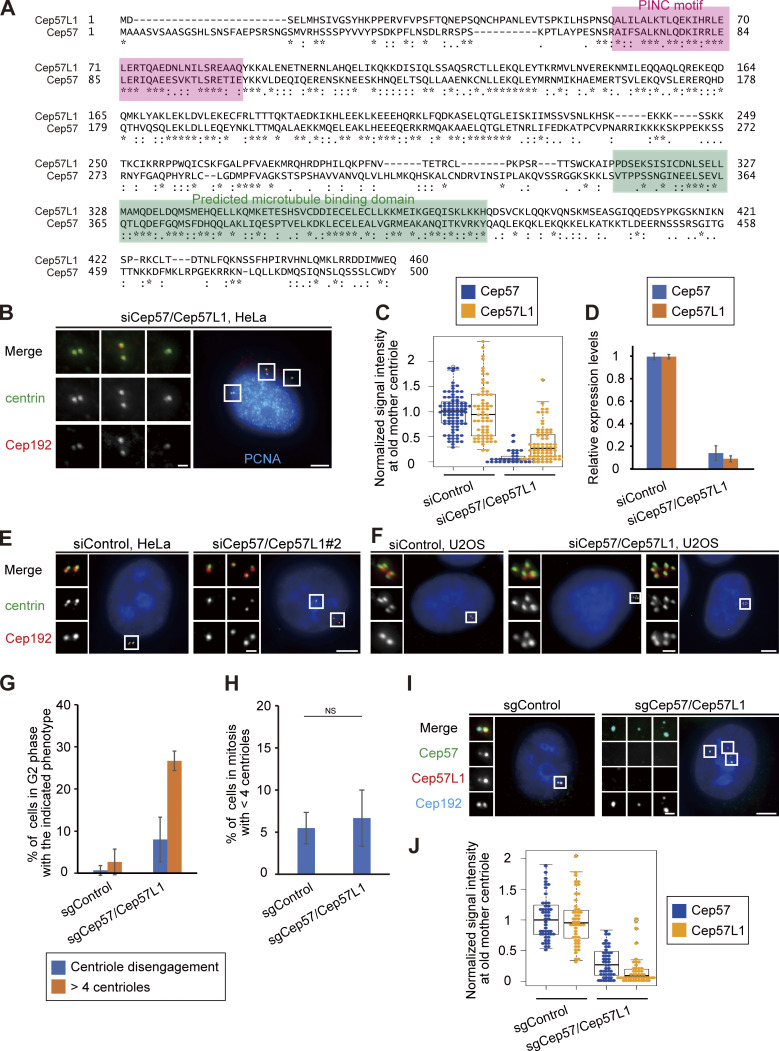Figure S1.
Double depletion of Cep57 and Cep57L1 causes precocious centriole disengagement in interphase. (A) Alignments of full-length H. sapiens Cep57L1 and Cep57. Asterisks indicate the residues identical in aligned sequence; colons indicate conserved substitutions; periods indicate semiconserved substitutions. The positions of the PINC motif and the predicted microtubule-binding domain are indicated in pink and green boxes, respectively. (B) Cep57/Cep57L1-depleted cells with disengaged or more than four centrioles possessed more than two Cep192 foci even in the S phase. HeLa cells were treated with siCep57/Cep57L1 and immunostained with antibodies against centrin (green), Cep192 (red), and PCNA (cyan). (C) Beeswarm plots piled on boxplots represent the normalized signal intensity of Cep57 and Cep57L1 at the old mother centrioles upon siControl and siCep57/Cep57L1 (n = 50). (D) Expression levels of Cep57 and Cep57L1 were quantified by RT-qPCR in control and Cep57/Cep57L1-depleted cells. Values are normalized expression levels ± SD from triplicated experiments. (E) The phenotype induced by Cep57/Cep57L1 codepletion was confirmed by using another siRNA. HeLa cells were treated with siCep57 and siCep57L1 no. 2 and immunostained with antibodies against centrin (green) and Cep192 (red). siCep57L1 no. 2 targets a different sequence in ORF from siCep57L1 no. 1, which is used in the main figures. (F) U2OS cells also exhibited precocious centriole disengagement and amplified centrioles upon Cep57/Cep57L1 codepletion. U2OS cells were treated with siControl or siCep57/Cep57L1 and immunostained with antibodies against centrin (green) and Cep192 (red). (G) CRISPR/Cas9-mediated codepletion of Cep57 and Cep57L1 induces precocious centriole disengagement and centriole amplification. HeLa cells stably expressing Cas9 were treated with control sgRNA (sgControl) or sgRNAs targeting Cep57 and Cep57L1 (sgCep57/Cep57L1). Values are mean percentages ± SD from three independent experiments (n = 50 for each experiment). (H) CRISPR/Cas9-mediated codepletion of Cep57 and Cep57L1 did not induce a reduction in the centriole number in mitosis. HeLa cells stably expressing Cas9 were treated with control sgRNA (sgControl) or sgRNAs targeting Cep57 and Cep57L1 (sgCep57/Cep57L1). Values are mean percentages ± SD from three independent experiments (n = 30 for each experiment). (I) CRISPR/Cas9-mediated codepletion of Cep57 and Cep57L1 was validated. HeLa cells stably expressing Cas9 were treated with control sgRNA (sgControl) or sgRNAs targeting Cep57 and Cep57L1 (sgCep57/Cep57L1) and immunostained with antibodies against Cep57 (green), Cep57L1 (red), and Cep192 (cyan). (J) Beeswarm plots piled on boxplots represent the normalized signal intensity of Cep57 and Cep57L1 at the old mother centrioles upon sgControl and sgCep57/Cep57L1 (n = 50). All scale bars, 5 µm in the low-magnification view, 1 µm in the inset. A two-tailed, unpaired Student’s t test was used in H to obtain P value. NS, P > 0.05.

